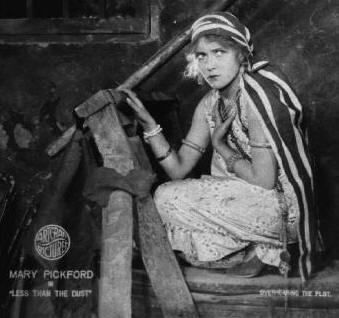Less than the Dust
 "Incredibly
bad," according to Pickford herself, "probably the worst film she ever
made," says Pickford's biographer Scott Eyeman . . . but not without a
certain popular appeal, as this opening day review in The New York Times
(Nov. 6, 1916, p. 9) suggests:
"Incredibly
bad," according to Pickford herself, "probably the worst film she ever
made," says Pickford's biographer Scott Eyeman . . . but not without a
certain popular appeal, as this opening day review in The New York Times
(Nov. 6, 1916, p. 9) suggests:
Two New Star Films.
Mary Pickford and Douglas Fairbanks Draw Drizzly Day Crowds.
It never rains but it pours in movie land. Yesterday, for instance, Mary Pickford and Douglas Fairbanks came to town in new pictures, and it cut into one's day fearfully to see both of them. A great many did, however, and in spite of the bleak and drizzly November day hundreds waited in line before the Rialto, the scene of the Fairbanks revelation, and before the Strand, Broadway, and Academy of Music, where copies of Miss Mary's photoplay were exhibited synchronously, for a chance to enter and pay tribute.
Miss Pickford's film was "Less Than the Dust," a title Hector Turnbull, its author, borrowed from one of Laurence Hope's Indian love lyrics, made familiar by the musical setting given to it by Amy Woodford-Finden. Mr. Turnbull has borrowed the idea behind the poem, of a girl who looks upon herself as less than the dust beneath the chariot wheel of her master, and has evolved a pretty story that gives this accomplished screen artist many opportunities to display her talents.
Her rôle is that of a little English girl who is left by her father, a dissolute officer in the British army serving in India, to a low caste Indian. She passes the early years of her life in the home of the swordmaker and only learns of her gentle birth when he is sent to prison for participation in a revolt. Then she goes to England to seek out her relatives , to find that the young man invalided in the great country house of her grandfather is none other than the young officer whose life she saved during the rebellion.
The eastern scenes are atmospheric enough, with their swarms of dark-skinned men and women and their backgrounds of rich verdure and buildings of Oriental architecture. The presence of the girl amid surroundings of Occidental culture presents many chances for the rather
naïve kind of humor Miss Pickford knows so well how to convey. The contrast between her eastern and western selves brings out the quality she possesses in greater degree than perhaps any other screen actress--the faculty of reflecting in appearance, like a chameleon, the nature of her surroundings.
 "Incredibly
bad," according to Pickford herself, "probably the worst film she ever
made," says Pickford's biographer Scott Eyeman . . . but not without a
certain popular appeal, as this opening day review in The New York Times
(Nov. 6, 1916, p. 9) suggests:
"Incredibly
bad," according to Pickford herself, "probably the worst film she ever
made," says Pickford's biographer Scott Eyeman . . . but not without a
certain popular appeal, as this opening day review in The New York Times
(Nov. 6, 1916, p. 9) suggests: